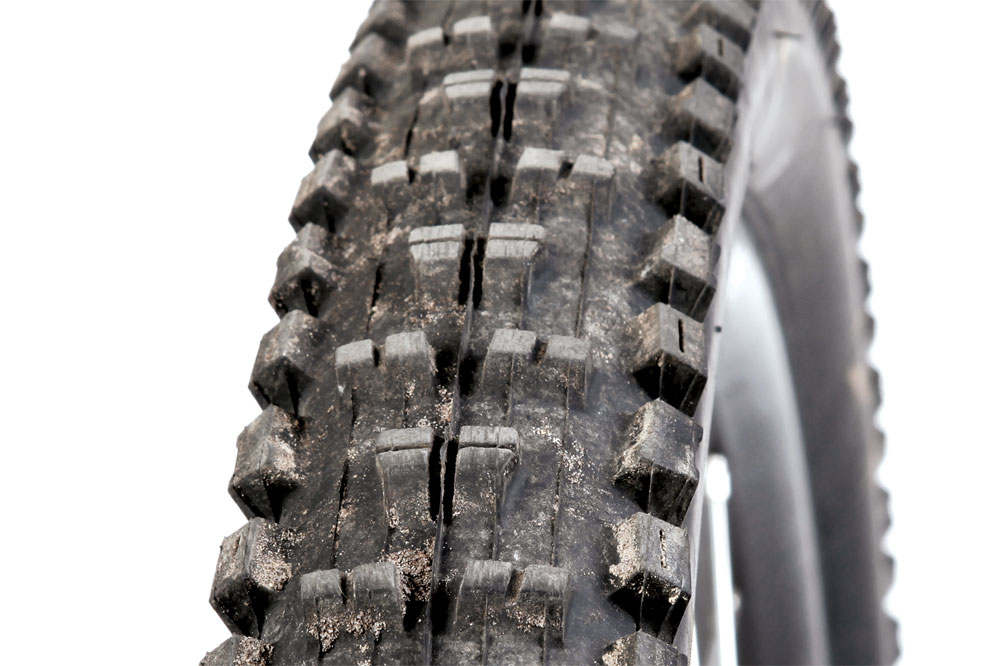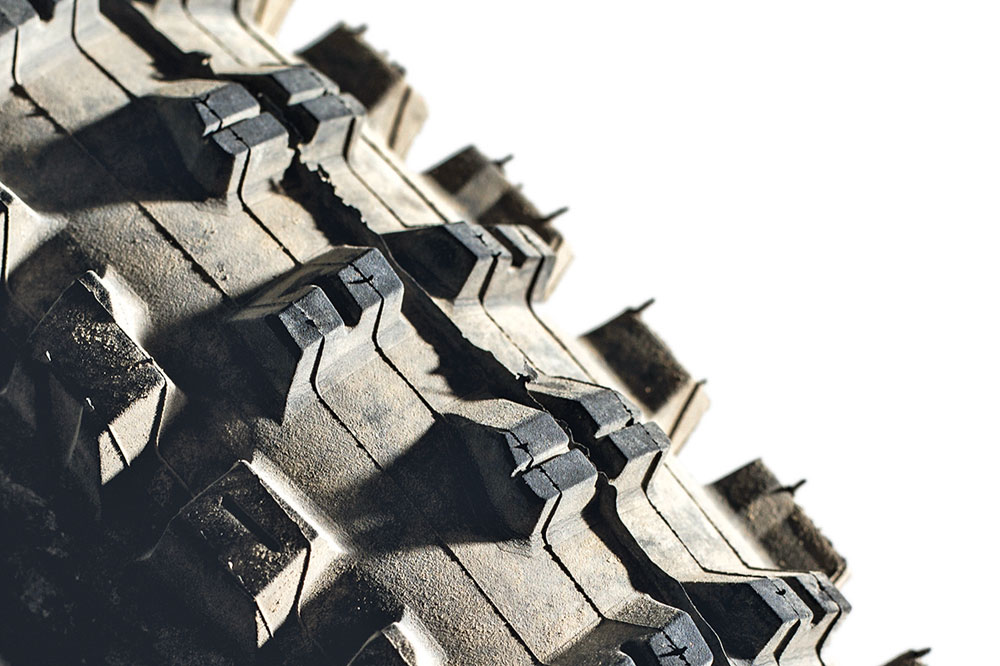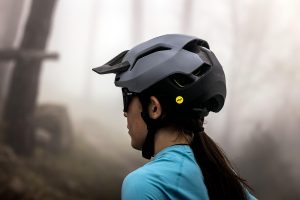Whether you're after out-and-out grip, quick rolling rubber, traction in the mud or something on a budget, we've got the best tyre for the job
With so many tyres around today, choosing the right one for your bike and riding style can be a minefield. With multiple rubber compounds, carcass builds and weight, tread patterns and widths, it can be confusing to say the least… and an expensive mistake if you get it wrong.
That’s why we’ve tested pretty much every tyre going, from the best mountain bike mud tyres to the quickest rolling rears, to produce THE definitive list of recommended rubber. We’ve concentrated on trail and enduro tyres, since they cover the most popular forms of riding and help you exploit the capability of a modern mountain bike on modern trails.
And don’t forget to check out our guide to the best mountain bike tubeless inflators and floor pumps to help get them set up.

The Maxxis Assegai is the best all round mountain bike tyre, it works predictably in almost all conditions and rolls well too
1. Maxxis Assegai tyre
Best all-rounder mountain bike tyre
Weight: 1,330g | Size tested: 29 x 2.5in | Actual size: N/A | Rating: 10/10
Reasons to buy:
- Great at hard cornering
- Perfect blend of grip, damping and rolling speed
Reasons to avoid:
- Not light
- Can be draggy if you get the MaxxGrip softer compound
Maxxis broke the mould when it invented the Assegai. It’s our favourite front tyre right now, because it’s miraculously able to do everything right, delivering high levels of grip in pretty much all conditions. From dust to mud, roots to rocks, the Assegai is never overwhelmed and lets you get on with the job of riding your bike.
Which compound should you go for? That’s always a tricky question with tyres because they come in so many different variants, but the 3C Maxx Terra, EXO+ version is our pick. It uses a reinforced, single-ply, construction, and slightly harder rubber compound, which means it rolls well but still generates great traction.
The Achilles heel? Thick mud can choke it, but of course then you’ll want to switch to the best mud tyre out there. Until that happens, it’s the tyre 90% of us should be riding.
Read our full test review of Maxxis Assegai tyre

The Schwalbe Tacky Chan is all about speed, it’ll gain you crucial seconds between the tape thanks to its fast acceleration and cornering grip
2. Schwalbe Tacky Chan tyre
Best gravity race tyre
Weight: 1,340g | Size tested: 29 x 2.4in | Actual size: 60mm | Rating: 9/10
Reasons to buy:
- Huge edge grip levels for cornering when loaded
- Fast rolling for a DH tyre
- Good muck clearing and braking bite
Reasons to avoid:
- Wears out fast in Addix Ultra Soft.
- Extreme precision wouldn’t suit everyone.
- Expensive, with spec options between £68.99 – £74.99
The Tacky Chan is all about speed, it’s available in 2.4in only across 27.5in and 29er wheels to lessen drag, all the while keeping extraordinary levels of grip when loaded into the corners. That makes it spot on if you’re going racing, it’ll gain you a few extra seconds when pushed to the limits, something that’s hard to put a price on.
Just don’t expect much comfort from the Tacky Chan, it’s lighter and quicker than the Schwalbe Magic Mary, accelerates like lightening, but you’ll feel it on the rough stuff.
Read our full test review of the Schwalbe Tacky Chan tyre

The Specialized Eliminator T7 rolls quick and brakes reasonably well, plus it’s not pricey so you won’t mind scrubbing it off on the eeb
3. Specialized Eliminator Grid T7 tyre
Best value rear tyre
Weight: 955g | Size tested: 29 x 2.3in | Sizes: 27.5/29in x 2.3/2.6in | Actual size: N/A | Rating: 9/10
Reasons to buy:
- Excellent value
- Fast rolling
- Works great as a rear tyre
Reasons to avoid:
- Not the best cornering grip
The Specialized Eliminator is a cracking rear tyre for enduro or e-bike use. That’s thanks to its great inflated shape that delivers a seamless transition between leant over cornering grip and upright rolling speed.
The casing is tough and supportive too, just what you need on a rear tyre, and the braking performance is surprisingly good. Couple that with quick rolling speed and a price that’s literally half that of the competition and you have our favourite budget rear tyre.
Read our full test review of Specialized Eliminator Grid T7 tyre

The Continental Kryptotal is like a drug, drip feeding you grip that you just can’t give up on
4. Continental Kryptotal Enduro R Soft tyre
Best tyre for pure grip
Weight: 1,080g | Size tested: 29 x 2.4in | Actual size: N/A | Rating: 9/10
Reasons to buy:
- Grip is superb
- Stiff casing lets you run lower pressures
- Decent rolling speed
Reasons to avoid:
- Not available in a lighter casing – yet
The Continental Kryptotal is an addictive tyre, it hooks you on ridiculous levels of grip it’s hard to go back to anything else. Primarily designed for mixed conditions, it’s part of Continental’s resurgence and represents one of the best new tyres we’ve seen in years.
The Kryptotal is end-specific, meaning there’s a rear with fat ramped central lugs for braking, and a front option with squarer central knobs to bite into the trail. Both feel calm and planted, sticky almost, and take vibrations and small chatter out of the trail all without dulling the experience. Welcome back, Conti.
Read our full test review of Continental Kryptotal Enduro R Soft tyre
The DHRII is a brilliant rear tyre, prioritising braking traction and rolling speed
5. Maxxis Minion DHR II tyre
Best rear tyre for mixed conditions (and great up front)
Weight: 1,010g | Size tested: 29 x 2.4in | Actual size: 60.4mm | Rating: 10/10
Reasons to buy:
- Excellent grip without excess drag
- It works really well on the front too!
Reasons to avoid:
- Multiple versions can be confusing (get 3C MaxxTerra for rear tyre)
- Slightly undersized compared to other beefier brands
The DHR II is the best rear tyre on the market right now. With big lugs running perpendicular to the trail it’s excellent at scrubbing off speed, and there’s enough space between them to shed loam and avoid becoming choked up and encased in slippy mud.
Bizarrely then, it also works great as a front tyre, the chunky tetris-shaped side lugs and heavily siped square knobs alternate to find grip in mixed and loose conditions, and the DHR II generates good grip without the Assegai weight penalty.
Read our full test review of Maxxis Minion DHR II tyre

6. E*thirteen Grappler Enduro MoPo tyre
Best value all-rounder
Weight: 1,040g | Size tested: 29 x 2.4in (also available in 27.5 x 2.5in) | Actual size: N/A | Rating: 10/10
Reasons to buy:
- Excellent sticky compound, great grip, impressive damping
Reasons to avoid:
- Er, do we have to put something here? It’s basically faultless.
Even in the toughest conditions, from wet to dry, rocky to loamy, the extra sticky MoPo rubber blend will blow you away with its grip. The secret formula lets the tyre’s lugs conform to the trail with poise and regularity, producing oodles of confidence. This seems to be true of any surface, from greasy dirt to rocks and roots.
Grappler is available in two casing and compound options, including a thick dual ply version designed for DH and enduro racing on the hardest tracks in the world. You don’t need race team funding to get the Grappler either, its surprisingly good value.
Read our full test review of the E*thirteen Grappler Enduro MoPo tyre
 7. Specialized Hillbilly Grid Gravity T9
7. Specialized Hillbilly Grid Gravity T9
Best value mud tyre
Weight: 1,360g | Size tested: 29 x 2.4in | Rating: 10/10
Reasons to buy:
- The excellent price
- Works great on slimy roots and rocks as well as loose mud
- Fine in drier conditions too
- Tough and durable
Reasons to avoid:
- One of the heaviest DH/Enduro mud tyres around
- Slower rolling than some similar tyres
Specialized tyres are great value, and that tradition continues with the Hillbilly, which is around a third less than the competition. That doesn’t stop it laying down some serious grip though, it’s heavy and slow rolling for sure, but its ability to slice through mud is unmatched.
The lugs are tall enough to dig into all but the deepest mud, but they’re well supported enough to find grip on hard surfaces like rock too. In fact, the Hillbilly manages to work well in dry conditions too, although the slow rolling speed will soon force a swap out once the trails dry out.
Read review of the Specialized Hillbilly Grid Gravity T9
How we tested the best mountain bike tyres:
For back-to-back testing, all tyres were set up tubeless on modern, wider rims and hammered hard at various spots, both in the UK and abroad. The same bike was used for comparison laps on the same hill, giving direct final analysis between brands. Air pressures were set dependant on casing thickness and suppleness for optimum ride feel for each brand and tyre – mostly around 28psi rear, and 25psi front. Thanks to recent hot spell of weather, we were in the unusual position of not riding one of the newest tyres in the wet, but rain on the before our test completion meant we were able to carry out some 11th hour wet weather testing too.
What do I need to look for in the best mountain bike tyres?
Tyres are a vital piece of kit that connect your bike to the trails. They control everything from cornering grip to braking traction, and rolling speed to cushioning and comfort. These multiple factors can totally transform your ride experience, and can actively keep you safer on a variety of trails and help prevent crashes..
Modern tyres are continually improving, so compound blends, tread patterns, and construction technologies are better than ever, allowing harder riding with less downtime. In fact, if you set up the right tyre tubeless, and you’re prepared to compromise a little on weight, it can deliver huge levels of grip and virtually eliminate cuts or punctures.

Sidewall information centre
How much difference does the rubber compound make?
Rubber hardness is measured by a durometer on the shore scale. Higher numbers signify firmer compounds: 60a is harder and longer lasting than 50a rubber. The secret ingredients and rubber chemistry tyre brands use are something of a mystery and can also make a huge difference to grip, rebound damping and rolling speed. So the answer is that rubber compounds make a significant difference, and you need to decide whether you are prioritising ultimate grip (in wet or dry) or low rolling resistance, along with other factors such as weight, casing stiffness and width.

Tread knobblies
What do differences in tyre tread pattern make to performance?
Widely-spaced treads bite better in looser surfaces and clear mud more effectively, but can also increase rolling resistance. Sipes and cuts help braking and the way the tyre deforms to obstacles. A more pronounced channel between shoulder and centre knobs can deliver better off-camber bite and a sensation of ‘railing’ turns, but some riders prefer a more continuous, rounded feel than the on/off grip generated by such a tread gap.

Sizing info, but 60psi is a maximum pressure, not a guide pressure!
What air pressure should I run in my tyres?
Different tyres require specific air pressures. A rough rule of thumb is: the thicker the casing, the lower the air pressure you can get away with. Equally, the bigger the tyre volume, the lower the pressure you can run, and vice versa. For maximum comfort and grip, aim for the minimum pressure that keeps the casing from twisting too much and still prevents rim strikes under impacts. Experiment with lower pressures if you often run over 30psi.
What about casing construction?
Casing thickness and precise ply lay-up has a big impact on ride quality and affects conformity, rolling speed and durability. Harder charging riders might have to accept the extra weight of meatier casings to prevent punctures and stop sidewalls folding under cornering forces. Heavier tyres accelerate more slower, but feel more planted and stable once momentum takes hold. Tubeless is always the way to go – inner tubes feel dead and lifeless, and cause more issues in our experience.
Should I choose a wider or narrower width tyre?
Using wider tyres up front for extra grip and comfort makes good sense. Arms get more cushioning and comfort, and, like skis, narrower rears can help initiate faster turning. Tyre width is directly relative to air volume, and larger volumes provide more isolation, damping and control, up to a point. Wider tyres add weight for climbing and acceleration, but rolling speed between different widths should be so close off-road, it’s not such an issue.
What kind of weight are modern MTB trail tyres?
Wider, more aggressive tyres need lots of support to keep tread blocks stable and use more casing material and rubber, which all adds weight. Bigger, heavier tyres can stabilise the bike by being harder to deflect at speed and larger air volumes offer more isolation from the ground too – especially useful to smooth out rougher terrain on shorter travel rigs. Now, anything under 1,000g is considered relatively light, while over 1,200g is heavy for enduro/trail use.

Ramped knobs reduce rolling resistance
Are front specific mountain bike tyres worth considering?
Using wider tyres up front for extra grip and comfort makes a lot of sense. Hands get extra cushioning, and slightly narrower rear tyres can also help initiate faster turning. Tyre width is directly relative to air volume, though, and a larger air volume provides more isolation, damping and control.

A speedy rear tyre can help with pace and energy levels
Are rear specific mountain bike tyres worth considering?
With a faster rolling, lower profile centre strip and pronounced edge blocks for leant-over grip, semi-slick tyres can be a great UK option. This is why we’ve largely resigned full-on XC tyres to history for trail riding. The extra bonus of the slip-to-grip attitude of semi slicks makes them a real hoot in greasier conditions.

















